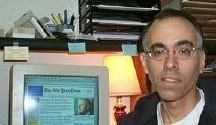
-----
OH&S student is looking for info re: sandblasting asap
Assignment to refinish aircraft hangar doors. Each "pocket" door consists of three steel panels 8.1m wide by 10 m high and 15mm thick. Panels fold into side of hangar. I must find out how these doors would be sandblasted, prepared and painted; analyze all safety hazards; and recommend controls. Safety issues and controls are not likely to be a problem for me, but I have no idea where to begin re sandblasting. I would appreciate any descriptions anyone would care to give re the process and equipment/materials used. Thanks in advance to all who may care to respond.
Linda Magill- Trenton, Ontario, Canada
1999
You can't not have a problem with safety hazards and controls if you don't know where to begin re sandblasting. There are all kinds of hazards of sandblasting, since the worker and the surrounding area and aircraft must be protected from the Si dust (or whatever you decide to use) of the sandblast media.
Then you must worry about what hazardous material you make from the media and the blasted paint, so you probably have to test the paint first.
Then you must decide what prepaint coating may be needed to get adhesion and good corrosion protection, knowing that hexavalent conversion coatings, phosphate coatings and/or primers are often used.
Then you have to know the VOC of the paint (or will you use powder?), explosion hazards of spraying, health hazards of organic solvents, if used...hoo boy, that's a good assignment, with dozens of issues each big enough for a thesis. You'll be a great consultant someday! Good Luck!

Tom Pullizzi
Falls Township, Pennsylvania
1999
Thanks Tom. I had thought of the hazards with the Si dust and the lead based paint I'll be removing; but due to my ignorance of the process, I had no concern about the primer or the explosion hazards of spraying. Your response will give me much more to go on.
I still need, however, a description of the sandblasting process; can you give me an idea where to look to find out what type of equipment is used and how it is done? Thanks again for any help anyone can give me.
- Trenton, ON Canada
1999
Have you read the W.A. Burgess book
Recognition of Health Hazards in Industry? It's short but gives a good overview of processes.
Additionally, there are some pretty great web sites out there on abrasive blasting (eg. www.ultranet.com/~dlandry/pblast/equip.htm) and I would also contact a blast equipment vendor for better description/explanation of the process. Also, in terms of spray painting and all the surface prep stuff: hopefully they won't need to do much but at least most of this can be flowed on vs. aerosolized (Alodining etc.). The primer? If possible, tell them to use non-chromated ones. Spray painting in general? encourage the use of HVLP. With the proper tip pressure and gun adjustment, you can really go a long way in minimizing airborne solvents. You might not even be getting into the % LEL range.
- seattle, Washington
1999
A physical description of the mechanical energy principle of sandblast is the acceleration of a sized media via the energy of centrifugal force or compressed air to achieve an impingement velocity where the inertial energy of the particulate will deform the surface, E=MC2. Generally the smallest particle that will entirely penetrate the coating will be the fastest in cleaning as at some point you have to start regarding the number of particles per minute as part of the mass equation. C is the velocity of the particle which tends to fall in larger mass particles. Stripping air plane parts is very difficult as you don't want peening, metal removal or additional metal fatigue. Most of the industry uses plastic medias to eliminate the first two factors but the metal fatigue inherent in air plane metals is generated by air flow during flight. The blast flow with media tends to add to this so you will want to use a low angle of incidence. Another discovery is a device that uses subharmonic energy waves to relieve metal fatigue, this can be found under Metalax a company in lower Michigan. You don't want to relieve all residual stress in stamp formed metals as the residual stress is what makes it hold it's shape.
Tom Paupore- Wisconsin Rapids, Wis
2001
Q, A, or Comment on THIS thread -or- Start a NEW Thread